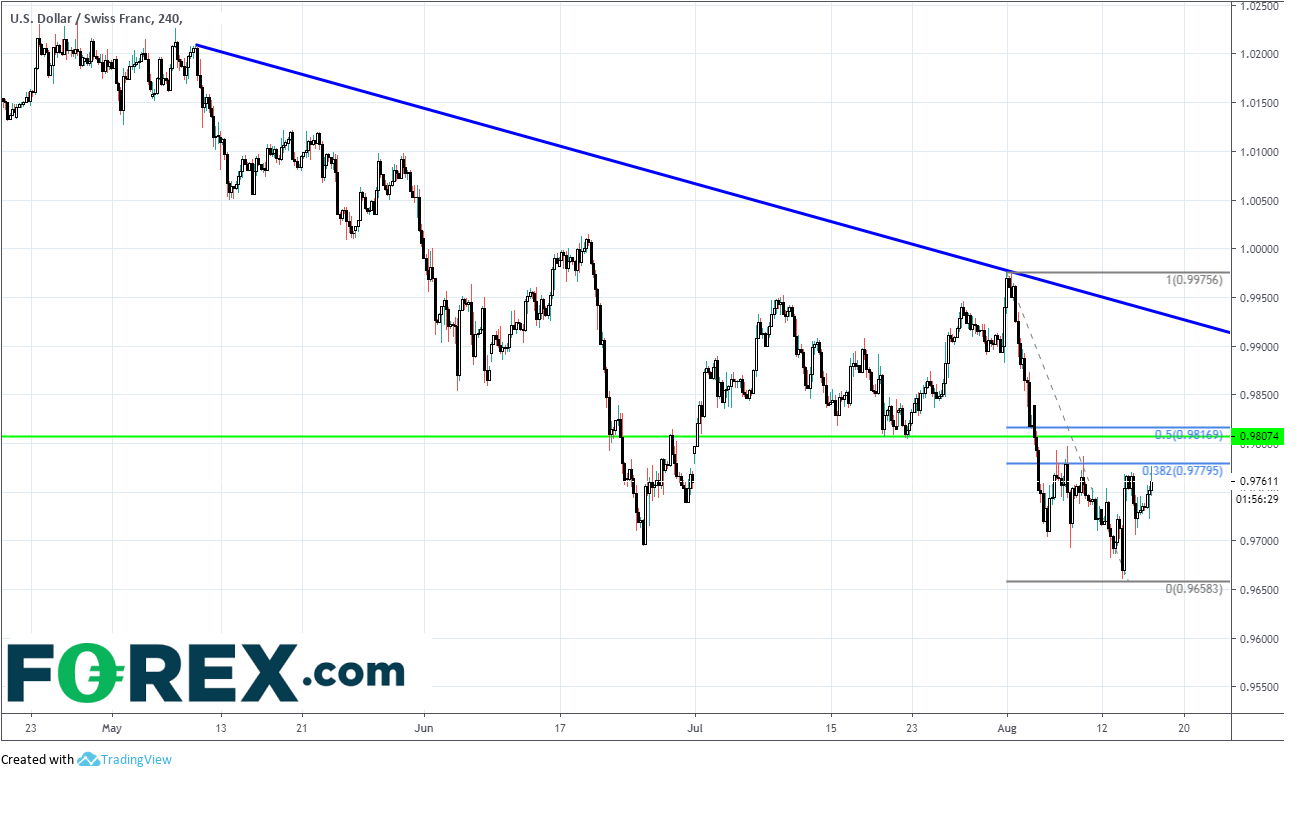Historically, the Swiss Franc has been considered to be a “Flight to Safety”. In other words, as risky assets begin to sell off, such as stocks, one may consider selling the USD and buying CHF. Therefore, selling USD/CHF makes sense when there is a risk off move.
However, over the last few years the Swiss National Bank has given the market reason to reconsider this thinking. (To be more specific, the unreliability of the SNB began on January 15, 2015 when the SNB depegged the Euro from the Swiss Franc and EUR/CHF began to freefall). Since then, the SNB has been intervening in the currency markets to prop up the Swiss Franc pairs.
Therefore, when we see risk off moves these days, the Swiss Franc is not necessarily considered to be the “Flight to Safety” that it once was.
USD/CHF has been in an upward channel since March of 2018. On Monday, the pair broke lower through the bottom Trendline at .9735, and quickly bounced back into the channel the next day, creating a false breakdown. In addition, the RSI is now diverging from price, and the pair put in a lower level on price, however a higher level on the RSI.
Source: Tradingview, FOREX.com
A move above resistance at .9780, which is the 38.2% retracement level from the .9977 high on August 1st, to the low of .9658 on August 6th, may be a signal to buy USD/CHF.
Source: Tradingview, FOREX.com
Risk Warning Notice Foreign Exchange and CFD trading are high risk and not suitable for everyone. You should carefully consider your investment objectives, level of experience and risk appetite before making a decision to trade with us. Most importantly, do not invest money you cannot afford to lose. There is considerable exposure to risk in any off-exchange transaction, including, but not limited to, leverage, creditworthiness, limited regulatory protection and market volatility that may substantially affect the price, or liquidity of the markets that you are trading. Margin and leverage To open a leveraged CFD or forex trade you will need to deposit money with us as margin. Margin is typically a relatively small proportion of the overall contract value. For example a contract trading on leverage of 100:1 will require margin of just 1% of the contract value. This means that a small price movement in the underlying will result in large movement in the value of your trade – this can work in your favour, or result in substantial losses. Your may lose your initial deposit and be required to deposit additional margin in order to maintain your position. If you fail to meet any margin requirement your position will be liquidated and you will be responsible for any resulting losses.
Recommended Content
Editors’ Picks
EUR/USD fluctuates near 1.0700 after US data

EUR/USD stays in a consolidation phase at around 1.0700 in the American session on Wednesday. The data from the US showed a strong increase in Durable Goods Orders, supporting the USD and making it difficult for the pair to gain traction.
USD/JPY refreshes 34-year high, attacks 155.00 as intervention risks loom

USD/JPY is renewing a multi-decade high, closing in on 155.00. Traders turn cautious on heightened risks of Japan's FX intervention. Broad US Dollar rebound aids the upside in the major. US Durable Goods data are next on tap.
Gold stays in consolidation above $2,300

Gold finds it difficult to stage a rebound midweek following Monday's sharp decline but manages to hold above $2,300. The benchmark 10-year US Treasury bond yield stays in the green above 4.6% after US data, not allowing the pair to turn north.
Worldcoin looks set for comeback despite Nvidia’s 22% crash Premium

Worldcoin price is in a better position than last week's and shows signs of a potential comeback. This development occurs amid the sharp decline in the valuation of the popular GPU manufacturer Nvidia.
Three fundamentals for the week: US GDP, BoJ and the Fed's favorite inflation gauge stand out Premium

While it is hard to predict when geopolitical news erupts, the level of tension is lower – allowing for key data to have its say. This week's US figures are set to shape the Federal Reserve's decision next week – and the Bank of Japan may struggle to halt the Yen's deterioration.

